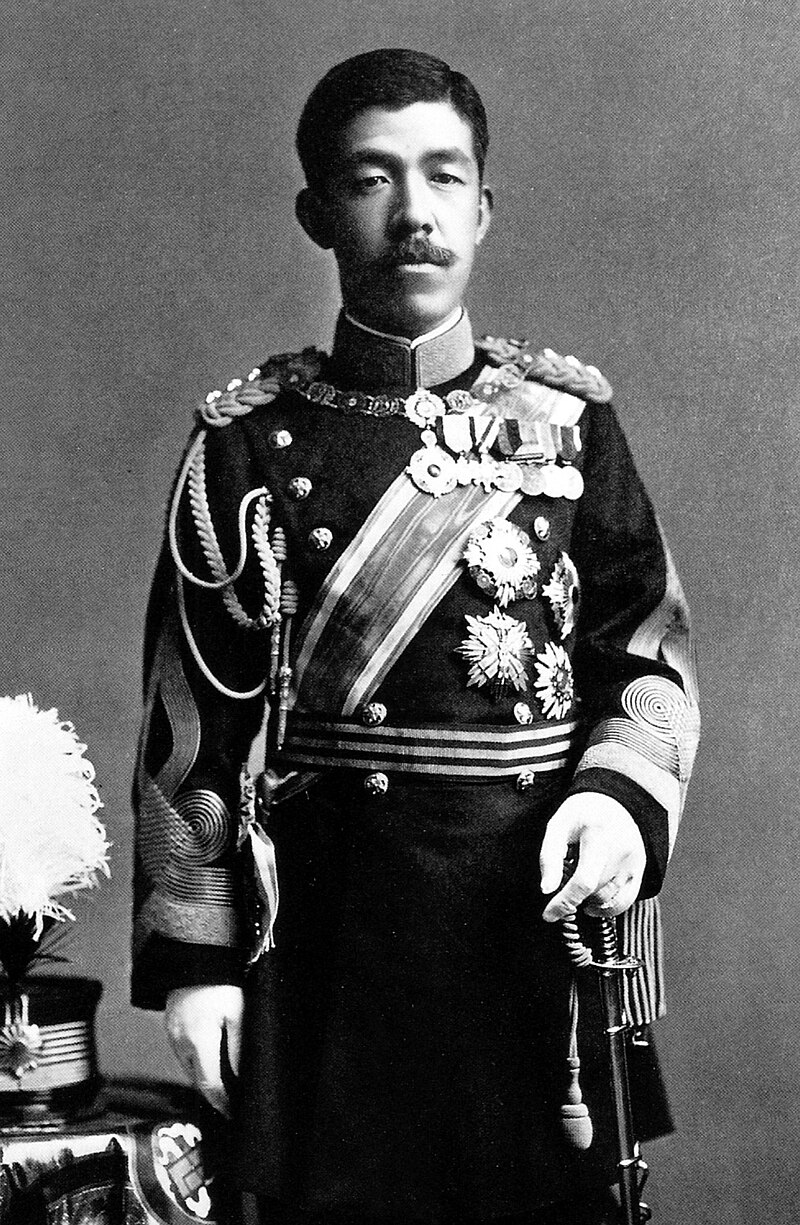by Susan Flantzer © Unofficial Royalty 2019

Emperor Taishō in 1912; Credit – Wikipedia
Emperor Taishō was born on August 31, 1879, at Tōgū Palace in Akasaka, Tokyo, Japan. His mother, Lady Naruko Yanagihara, was a concubine to his father Emperor Meiji and the daughter of imperial chamberlain Mitsunaru Yanagihara and was the last concubine to give birth to a Japanese emperor. He was given the childhood name Haru-no-miya and the personal name Yoshihito.

Emperor Meiji, Yoshihito’s father; Credit – Wikipedia

Yoshihito’s mother, Lady Naruko Yanagihara; Credit – Wikipedia
Emperor Meiji’s wife, known posthumously as Empress Shōken, had no children. However, Emperor Meiji had fifteen children by five official ladies-in-waiting but only five children survived to adulthood so Yoshihito had four half-siblings. The Empress officially adopted Yoshihito, her husband’s eldest surviving son by a concubine, as was the custom.
Yoshihito had four half-sisters, all born to Lady Sachiko Sono, one of Emperor Meiji’s five concubines:
- Sixth Daughter: Princess Masako (1888 – 1940), married Prince Tsunehisa Takeda, had one son and one daughter
- Seventh Daughter: Princess Fusako (1890 – 1974), married Prince Naruhisa Kitashirakawa, had one son and three daughters
- Eighth Daughter: Princess Nobuko (1891 – 1933), married Prince Yasuhiko Asaka, had two sons and two daughters
- Ninth Daughter: Princess Toshiko (1896 – 1978), married Prince Naruhiko Higashikuni, had four sons
Three weeks after his birth, Yoshihito suffered from cerebral meningitis and this affected his health and his mental capacity, including a speech disorder and difficulty walking, for the rest of his life. Until he was seven-years-old, Yoshihito was raised in the household of Tadayasu Nakayama, a Japanese nobleman and courtier, who had also raised his father Emperor Meiji.

Yoshihito in 1892; Credit – Wikipedia
On August 31, 1887, Yoshihito was officially declared heir to the throne and was then invested as Crown Prince on November 3, 1888. Eight-year-old Yoshihito entered the Gakushūin or Peers School in Tokyo, established to educate the children of the nobility, in September 1887. However, due to his health issues, he was often unable to continue his studies. Yoshihito spent much of his childhood at the seaside Imperial villas at Hayama and Numazu for health reasons. He did show some skill in some areas, such as horse riding but he was a poor student in areas requiring higher-level thinking. Because of this, Yoshihito eventually completely withdrew from Gakushūin in 1894. He had an aptitude for languages and received private tutoring in French, Chinese, and history. In 1898, Yoshihito began to attend sessions of the House of Peers of the Diet of Japan (legislature) to learn about the political and military concerns of the country.

Yoshihito in 1900, on his wedding day; Credit – Wikipedia

Sadako on her wedding day in 1900; Credit – Wikipedia
Yoshihito married 15-year-old Lady Sadako Kujō (Empress Teimei), daughter of Prince Michitaka Kujō, the head of the five senior branches of the Fujiwara clan, on May 10, 1900. Because of Yoshihito’s diminished mental capacity, Emperor Meiji wanted an intelligent, articulate, and dignified wife for his son, and he found those qualities in Sadako.

Wedding of Crown Prince Yoshihito and Princess Sadako Kujō; Credit – Wikipedia
Yoshihito did not have any concubines and he and his wife had four sons:
- Hirohito, Emperor Shōwa (1901 – 1989), married Princess Nagako of Kuni, Empress Kōjun, had two sons and five daughters including Emperor Akihito
- Prince Chichibua (1902 – 1953), married Setsuko Matsudaira, no children
- Prince Takamatsu (1905 – 1987), married Kikuko Tokugawa, no children
- Prince Mikasa (1915 – 2016), married Yuriko Takagi, had three sons and two daughters

Emperor Taishō’s four sons in 1921: Hirohito, Mikasa, Takamatsu, and Chichibu
Emperor Meiji died on July 30, 1912, and Yoshihito became Emperor of Japan. He is known by his posthumous name Taishō. Emperor Taishō was kept out of public view as much as possible because of his mental incapacity. Within a few years, it became apparent that he could not carry out any public functions, participate in daily government matters, or make decisions. This was all left to his ministers and his son Crown Prince Hirohito. Finally, Crown Prince Hirohito was named Prince Regent on November 25, 1921.
In early December 1926, it was announced that the Emperor had pneumonia. Emperor Taishō died of a heart attack on December 25, 1926, at the Hayama Imperial Villa in Hayama, Japan at the age of 47. He was buried at the Musashi Imperial Graveyard in Hachiōji, Tokyo, Japan.
Burial Site of Emperor Taishō; Credit – Staka – Own work, CC BY 3.0, https://commons.wikimedia.org/w/index.php?curid=3469393
This article is the intellectual property of Unofficial Royalty and is NOT TO BE COPIED, EDITED, OR POSTED IN ANY FORM ON ANOTHER WEBSITE under any circumstances. It is permissible to use a link that directs to Unofficial Royalty.
State of Japan Resources at Unofficial Royalty
- State of Japan Index
- Japanese Emperors
- Japanese Imperial Burial Sites
- Japanese Imperial Dates
- Japanese Imperial FAQs
- Japanese Imperial Weddings
- Line of Succession to the Chrysanthemum Throne
- Profiles of the Japanese Imperial Family
Works Cited
- De.wikipedia.org. (2018). Taishō. [online] Available at: https://de.wikipedia.org/wiki/Taish%C5%8D [Accessed 23 Oct. 2018].
- En.wikipedia.org. (2018). Emperor Taishō. [online] Available at: https://en.wikipedia.org/wiki/Emperor_Taish%C5%8D [Accessed 23 Oct. 2018].
- Ja.wikipedia.org. (2018). 大正天皇. [online] Available at: https://ja.wikipedia.org/wiki/%E5%A4%A7%E6%AD%A3%E5%A4%A9%E7%9A%87 [Accessed 23 Oct. 2018].
